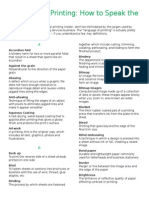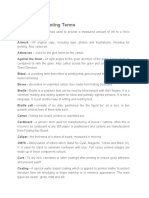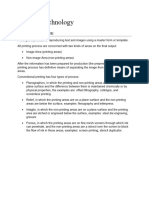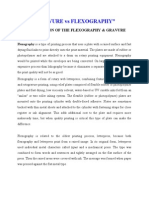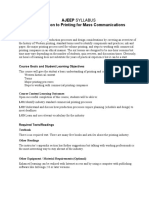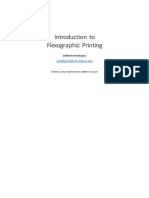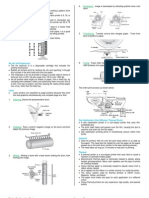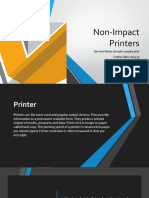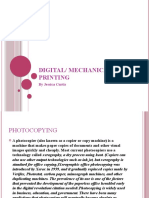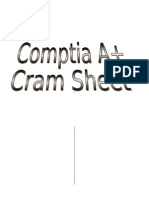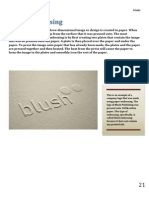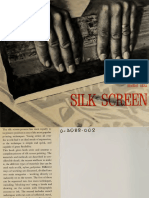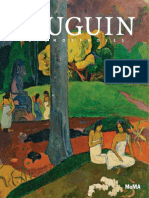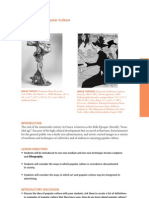Graphic Design & Multimedia Terminology
Aliasing
A "staircase" or jagged effect that occurs when display resolution is too coarse to minimize
the broken or crooked appearance of certain electronic design elements. Aliasing is more
visually pronounced in diagonal lines, curves, and circles.
Aqueous Coating
Water-based coating applied like ink by a printing press to protect and enhance the printed
surface.
Ascender
The part of a lower case letter which rises above the main body, as in "b" or "d."
Blanket
In offset printing, a rubber-surfaced fabric that is clamped around a cylinder. The image is
transferred from the plate to the blanket, and from there, transferred to the paper.
Bleed
Printed image which extends beyond the trim edge of the sheet or page.
Cast Coated Paper
Paper dried under pressure against a heated, polished cylinder to produce a high-gloss
enamel finish.
CMYK
Abbreviation for cyan, magenta, yellow, and key (black), the four process colors.
Coated Paper
Paper with a coating of clay or other substances that improves reflectivity and ink holdout.
Color Key™
3M’s negative overlay proofing films which visually simulate process printing inks.
Color Separations
The four-color negatives or positive that are the result of changing full color photos or art
into the four process colors (see CMYK) by the use of filters.
Computer-to-plate (C2P)
Describes a system in which the use of desktop publishing software, electronic prepress
workstations, and platesetters allows the imaging of metal plates for any format of press
without the use of film, stripping, or traditional platemaking. This process results in lower
costs while shortening the amount of time needed to get a job on the press. Sometimes also
called C2P to distinguish it from CTP, or computer-to-press.
Computer-to-press (CTP)
Describes a printing system that includes desktop publishing software, electronic prepress
workstations, and a new type of press which is capable of rapidly changing the images it is
printing without the use of removable plates. Sometimes
called CTP to distinguish it from C2P, or computer-to-plate.
Coverage
The amount of ink on a page or sheet, usually given in percentages.
Crop Marks
Symbols placed in the margin outside the image area that indicate to the printer and
bindery the area to be printed and/or trimmed from the final image.
Curl
The distortion of paper due to differences in structure or coatings from one side to the other
or from absorption of moisture on the press.
Descender
The part of a lower case letter which extends below the main body, as in "p."
Die
Device for cutting, scoring, stamping, embossing, or debossing.
Die Stamping
Printing from lettering or other designs engraved into copper or steel. Also called the
intaglio process, it is used for the production of letterheads, business cards, etc.
© 2002 by 321site.com · 1025 Oxford Lane #114 · Fort Collins, CO 80525 · 970.225.3821 · info@321site.com
�Diecutting
Using sharp steel rules to cut special shapes from printed sheets. Diecutting can be done on
either flatbed or rotary presses.
Dot Gain
The increase in the printing dot size from the halftone film to the printed substrate resulting
in darker tones.
Drawdown
Sample of inks specified for a job applied to the substrate specified for a job.
Drop Out
The technique that can give a mediocre photo greater contrast by photographically
removing some dots to create high-lights
that show the actual white of the paper.
Duotone
Two films are made by changing the screen angle for each, and one plate is made for each
film. A duotone is printed in two colors, but both plates can be used for the same color ink
for maximum contrast. When using black ink this is called a "double black."
Em
A measure of space exactly as high and wide as the point size of the type face being used.
Em Dash
A dash, one em long, used to separate parenthetical phrases within a sentence.
Emboss
To press an image into paper so it lies above the surface .
Emulsion
The light-sensitive coating on photographic film, plates, or stencils.
En
A measure of space equal to one-half of an em space in the same point size and type face.
En Dash
A dash, one en long, used to indicate range as in "see pages 4-5."
Engraving
Printing method using a plate, also called a die , with an image cut into its surface.
Fifth Color
Non-process or premixed ink color used in addition to the four process colors.
Fly Leaf
The half of the end sheets not glued to the front and back of a case bound book.
Foil Stamp
To press a heated die onto a sheet of foil, releasing its backing and adhering it to a
substrate.
Folio
In typesetting, the typeset page number. Right hand pages contain odd number folios.
Font
A complete set of type characters in one type face and type size.
Foot
The bottom of a page or book.
Foot Margin (also tail margin)
The distance between the bottom edge of the body of type (text) on a page and the bottom
edge of the trimmed page.
For Position Only (FPO)
Refers to inferior quality copies of photos or art used on mechanicals to indicate placement
and scaling, but not intended for reproduction.
Four-color Process
Use of cyan, magenta, yellow, and black to create a full color image.
© 2002 by 321site.com · 1025 Oxford Lane #114 · Fort Collins, CO 80525 · 970.225.3821 · info@321site.com
�Fulfillment
The storing of a customer’s materials until that customer requests delivery to itself or to a
third party. Also, the fulfilling by a vendor of a request received from a customer by phone,
mail, or electronic means. Also known as "pick and pack."
Galley Proof
A printout of text used for proofreading before final page assembly.
Gripper Edge
The leading edge of a sheet, which is held by the grippers.
Gripper Margin
The unprintable area of the paper where it is gripped as it passes through a printing press.
Usually measures a half inch or less.
Gutter
The inside margin of a bound page.
Hairline Register
Register within plus or minus one-half row of dots.
Halftone
An image composed of tiny dots whose variations in size create the illusion of variations in
tone. Traditionally, a halftone screen was used to convert a continuous tone image into a
halftone; such screening is currently done electronically.
Hickey
Spot on a printed sheet usually due to dust, lint, or bits of paper.
Imprinting
To print new copy on a previously printed sheet, such as imprinting an employee’s name on
business cards.
In-line
Components of a system arranged in a logical production sequence and in such a way that
materials are automatically fed to the next component. An example would be coating tower
on a press to apply the lacquer or UV coating on the same pass as the color.
Kiss Cut
To die cut the top layer but not the backing of self-adhesive paper.
Knock Out
To clear an area of absolutely every printing dot, or to outline an image and drop out all
dots surrounding it.
Laminate
To bond a plastic film by heat and pressure to a printed sheet for protection and
appearance.
Leading (ledd-ing)
The linespace, or white space, between lines of copy measured in points.
Leaf
One sheet of paper in a publication. Each side of a leaf is one page.
Letterpress
A method of printing where the wrong-reading raised surface of a printing plate is inked and
impressed directly onto paper. There are four types of letterpress presses: platen, flatbed
cylinder, rotary, and belt.
Lithography
Method of printing using plates whose image areas attract ink and whose non-image areas
repel ink. The images are first printed onto a rubber blanket and then offset to paper.
Loupe
Lens built into a small stand. Used to inspect copy, film, proofs, plates, and printing.
M
The abbreviation for magenta in the four-color process. Also the abbreviation for "one
thousand."
© 2002 by 321site.com · 1025 Oxford Lane #114 · Fort Collins, CO 80525 · 970.225.3821 · info@321site.com
�Magenta
One of the three subtractive primary colors of process printing. It is commonly called
"process red."
Makeready
The process of setting up and adjusting a printing press for a particular ink, paper, and set
of printing conditions prior to a press run. Also, the paper used during these adjustments.
Margin
The blank space around the image area of a page, also referred to as a gutter.
Matchprint™
3M’s negative or positive single sheet proofing system, which simulates SWOP
specifications.
Moire
Objectionable patterns that appear at regular frequencies when two or more screen patterns
are placed over one another. May be caused by misalignment, incorrect screen angles,
slipping, or slurring.
Mottle
Spotty or speckled printing.
Offset Printing
Usually refers to offset lithography. The image prints by transferring ink from a flat plate or
cylinder to a rubber blanket that deposits the ink onto the substrate instead of directly from
plate to paper.
Palette
The collection of colors or shades available or used in a project, graphic system, or
program.
Panel
One page of a brochure on one side of the paper. A letter folded sheet has six panels.
Perfect Binding
Signatures that are folded and collated on top of one another, as opposed to saddle-stitch
binding in which the signatures are folded inside one another.
Pica
Unit of measurement commonly used in typesetting and design. A pica is one-sixth of an
inch.
Plate
Piece of paper, metal, plastic, or rubber carrying an image to be reproduced using a printing
press.
PMS
Acronym for Pantone Matching System, a set of preprinted color patches used to choose and
communicate color so exact matches can be obtained.
Point
Unit of measurement commonly used to specify type sizes. There are twelve points in a pica
and 72 points in an inch.
Positive
A reproduction that is exactly like the original.
Post Bind
To bind using a screw and post inserted through a hole in a pile of loose sheets.
Prepress
Camera work, color separating, stripping, platemaking, and other functions performed by
the printer, separator, or service bureau prior to the actual printing.
Prepress Proof
Any color proof made using ink jet, toner, dyes, or overlays.
© 2002 by 321site.com · 1025 Oxford Lane #114 · Fort Collins, CO 80525 · 970.225.3821 · info@321site.com
�Press Checks
When a customer is at the printing press as the press begins to print his or her job, in order
to approve the job as it is printed. A press check can last a few minutes or several days,
depending on the size of the job.
Primary Colors
The colorants of a system used to reproduce the colors for the entire reproduction. Cyan,
magenta, and yellow are subtractive primary colors while red, green, and blue are additive
primary colors.
Printer’s Spread
Two facing pages in the order they will be printed, e.g. pages 1 and 4 and also 2 and 3 will
be keylined together for a four-page brochure.
Process Colors
The three colors (cyan, magenta, and yellow) plus black that are used in full-color printing.
Process Color Separation
A consequence of the offset lithographic process. In order to print full-color images, it is
necessary to prepare four separate files for each of the process colors (cyan, magenta,
yellow, and black). When the colors are overprinted, they combine
to render a wide range of color. CMYK produces the widest range of color with the fewest
inks when printing.
Process Inks
The ink colors of cyan, magenta, and yellow used to print color reproductions.
Ragged
Type that is not justified on the right or left side.
Ream
500 sheets of printing paper. Stacks and skids of paper often include slips of paper (ream
markers) marking the division of the stack into reams.
Recycled Paper
New paper made entirely or in part from old paper.
Register
The fitting of two or more printing images on the same paper in exact alignment with each
other.
Register Marks
Crosses or some other designs that are pasted outside your keyline on the board.
Everything done to the job through printing must have these marks to prevent the
separations, film, or plates from being misaligned or out of register.
Registration
The correct positioning of one color over another during the printing process.
RGB
Red, green, and blue. The additive primaries that are used in video monitors.
Right Reading
Copy that reads correctly in the language in which it is written. Also describes a photo
whose orientation looks like the original image.
Saddle-sewn
A form of binding that stitches thread through the gutter fold of a publication.
Saddle-stitched
A form of binding that uses staple-shaped wires through the gutter fold. Also called saddle-
wired.
Sans Serif Type
Any type style that does not have cross strokes on the ends of the letters.
Screen Tint
A halftone screen pattern of all the same size dots that creates an even tone.
Self Cover
A cover made from the same paper as the inside text pages.
© 2002 by 321site.com · 1025 Oxford Lane #114 · Fort Collins, CO 80525 · 970.225.3821 · info@321site.com
�Serif Type
Any type style that has cross strokes on the ends of the letters.
Service Bureau
A business that provides manipulation and output of digital files, usually to a PostScript
imagesetter.
Signature
A group of pages brought together into proper sequential order and alignment after it has
been folded.
Spine
The back of a bound book connecting the two covers. Also called backbone.
Spiral Bind
To bind using a spiral of continuous wire or plastic looped through holes. Also called coil
bind.
Spot Color
Individual color or colors that are utilized to highlight illustrations or type. Spot color is
frequently printed with non-process color inks, although process inks can be used.
Spot Varnish
Varnish applied only to certain portions of a sheet to highlight those areas.
Spread
Two facing pages. They can be a reader’s spread or a printer’s spread.
Step-and-repeat
The procedure of exposing an image repeatedly in different places on the printing plate.
Stripping
The process of manually creating composite films and fully imposed flats for platemaking.
SWOP
Abbreviation for the revised Specifications for Web-Offset Publications: a set of
specifications for color separation films and color proofing to ensure the consistency of the
printed color.
Tear Sheet
Actual ad removed from a publication and sent to the advertiser, often with the invoice.
Thermography
Method of printing using colorless resin powder that takes on the color of underlying ink.
TIFF
Tagged Image File Format. A graphics and page layout file format for desktop computers.
Used as an intermediary file format for both color and black and white images. TIFF is used
to transfer documents between different applications
and computer platforms.
Two-up
Having two images of each item (see one-up).
Uncoated Paper
Paper that has not been coated with clay.
UV Coating
Liquid applied to a printed sheet, then bonded and cured with ultraviolet light.
Varnish
A thin, protective liquid coating applied to the printed sheet for protection.
Vignette
An illustration in which the background fades gradually away until it blends into the
unprinted paper.
Waterless Lithography Sheetfed
Water-free offset lithographic capability on a sheetfed press that allows ultrafine
reproduction and improved, almost
continuous-looking halftones.
© 2002 by 321site.com · 1025 Oxford Lane #114 · Fort Collins, CO 80525 · 970.225.3821 · info@321site.com
�Waterless Lithography Web
Water-free offset lithographic capability on a web press that allows ultrafine reproduction
and improved, almost continuous-looking halftones.
Watermark
Translucent logo in paper created during manufacture by slight embossing while paper is
still approx i m a t e ly 90 percent water.
Web Press
A printing press that prints on paper from a continuous roll and outputs it onto another roll,
as a folded signature or as cut sheets.
Work and Tumble
To print one side of a sheet of paper, then turn the sheet over from gripper to back using
the same side guide and plate to print the second side.
Work and Turn
To print one side of a sheet of paper, then turn the sheet over from left to right and print
the second side. The same gripper and plate are used for printing both sides.
© 2002 by 321site.com · 1025 Oxford Lane #114 · Fort Collins, CO 80525 · 970.225.3821 · info@321site.com

